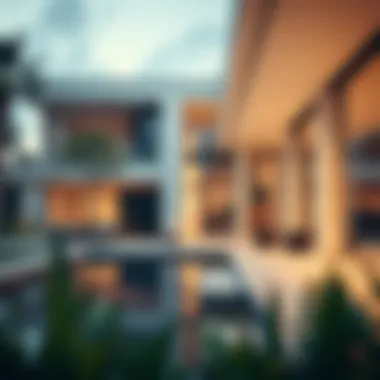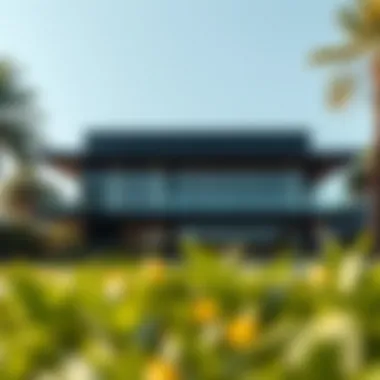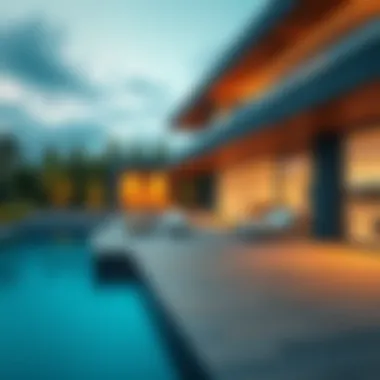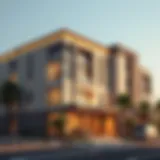Contemporary Villas: Modern Architectural Insights


Intro
The Dubai skyline is a testament to modernity, with its exceptional blend of skyscrapers and elegant villas that dot the landscape. Contemporary villas have not just become residences; they are symbols of luxury, innovation, and sophisticated living. As urban environments evolve, the architectural paradigms governing these villas continue to shift, incorporating a variety of cultural and technological influences.
The need for unique living spaces has spurred developers to move beyond traditional designs, embracing new materials and smart technology that cater to the desires of discerning homeowners. Amid today's dynamic real estate market in Dubai, understanding these contemporary villas and their implications for buyers and investors is paramount. This exploration goes beyond just aesthetics; it aims to provide a comprehensive understanding of the underlying construction techniques and lifestyle preferences that fuel the demand for these modern abodes.
Navigating the complexities of today's property market can be daunting, particularly when it comes to high-end villas. Factors such as location, sustainability, and innovative architectural trends must be weighed thoughtfully. By focusing on these elements, we can better appreciate not only the value of contemporary villas, but also how they redefine luxury living in an ever-changing urban context.
Understanding Contemporary Villas
With the ever-evolving landscapes of urban living, contemporary villas have emerged as a beacon of modern architecture, offering both aesthetic pleasure and functional living spaces. The significance of understanding contemporary villas extends beyond mere architectural appreciation; it's about recognizing how these designs align with the changing needs and desires of today's homeowners, particularly in dynamic markets like Dubai's real estate scene.
As societies shift, the architectural paradigms reflect those shifts. Contemporary villas often showcase a blend of elegance and pragmatism, seamlessly merging artistry with everyday usability. This strategic intersection is important; it emphasizes how these structures can not only serve as residences but also as lifestyle statements for those living within them.
Benefits of Understanding Contemporary Villas:
- Cultural Relevance: They embody current cultural trends and ideals, making them relevant within their communities.
- Investment Insight: An understanding helps investors recognize value and predict future market movements, providing that edge in real estate decisions.
- Architectural Trends: It offers insight into the latest innovations, encouraging homebuyers to appreciate the intricacies and potential of their living spaces.
In essence, comprehending contemporary villas digs deeper than aesthetics. It encourages a dialogue about how these homes function within larger societal frameworks—how they adapt, evolve, and ultimately define what modern living means today.
Defining Contemporary Architecture
Contemporary architecture can be defined as a reflection of current trends, methods, and technologies in the construction world. Unlike styles that have gone before, it embraces irregular shapes, new materials, and innovative construction techniques, often tailored specifically for the modern lifestyle. By breaking conventional mold, these homes tend to cater more effectively to the way people live and interact today.
Historical Development of Villa Designs
The evolution of villa designs has roots tracing back to ancient times, where villas were synonymous with luxury and leisure. Over decades, this idea shifted significantly due to cultural interactions, economic changes, and technological advancements. At the cusp of the 20th and 21st centuries, the notion of a villa began accommodating concepts of minimalism and sustainability, shaping what we now consider contemporary villas. Moreover, their design reflects societal values by integrating more natural elements and innovative technology.
Key Characteristics of Contemporary Villas
Simplicity and Clean Lines
Simplicity and clean lines define a penchant for clarity in design. The reduction of clutter and intricate detailing directs focus toward the essence of the structure itself, often leading to timeless beauty. This feature promotes the idea that less can indeed be more, allowing residents to live amidst open and airy spaces. A beneficial choice for many, clean lines streamline the visual experience, setting the stage for an uncluttered lifestyle.
Open Floor Plans
Open floor plans stand as an emblem of modern life. They provide flexibility, allowing families and individuals to move fluidly between spaces. The absence of walls encourages interaction, making them a popular choice for social gatherings. While an open concept indeed fosters togetherness, challenges like noise control and privacy can arise. Nonetheless, many find the benefits surpass these drawbacks, creating community within the confines of their homes.
Use of Natural Light
The strategic use of natural light is more than a design consideration; it fosters a psychological connection to the environment. Large windows, skylights, and glass doors invite the sun inside, enhancing mood and energy levels. Homeowners appreciate brightness and warmth, which converts living spaces into vibrant, welcoming habitats. However, it is crucial to balance this with temperature control to avoid excessive heat gain, particularly in regions with harsh weather.
The right blend of architectural elements can transform a simple villa into a breathtaking reflection of modern living.
Architectural Elements of Modern Villas
The architectural landscape of modern villas has shifted, carving out a distinct identity that aligns luxury with comfort and functionality. In this article, we’ll delve into some of the primary architectural elements that stand at the forefront of contemporary villa designs. These elements not only define aesthetic appeal but also tackle practical living needs, thus enhancing market value.
Materials and Finishes
Glass and Steel
Glass and steel are two materials that have taken the cake when it comes to contemporary villa design. The use of glass offers expansive views, creating a dialogue between the structure and its environment. It lets in natural light, making spaces feel open and inviting, which is especially appreciated in the sunny climates of places like Dubai. Steel, on the other hand, is known for its strength and flexibility in design, allowing architects to create stunning structures that can withstand time—an essential consideration in luxury properties.
However, using glass and steel isn't all sunshine and rainbows. While they lend a modern edge, they require careful insulation to balance energy efficiency and comfort, which can sometimes push costs higher. Yet, when done right, the result is breathtaking spaces that epitomize modern living.
Sustainable Materials
Sustainable materials are becoming the talk of the town in building contemporary villas. The growing awareness around environmental issues has led to a push for materials like bamboo, recycled wood, and eco-friendly composites that contribute to reducing the carbon footprint. Using these kinds of materials often reflects a conscientious approach to living—an attitude embedded in many modern developments.
One of their key characteristics is durability; sustainable materials are often designed to last longer and require less maintenance. That said, the upfront costs might be on the higher side, but that's just a small price to pay for the potential long-term savings and positive environmental impact they deliver.


Natural Stone
Natural stone, with its timeless appeal, remains a popular choice among villa builders. It evokes a sense of permanence and connection to nature, which many homeowners find appealing. Not only is it durable—standing strong against weathering—but it also adds a luxurious touch to designs, lining facades or transforming surfaces in ways that man-made materials often struggle to achieve.
The uniqueness of natural stone lies in its variety; no two pieces look exactly alike, adding character to the property. However, it does require a certain level of expertise to install correctly, and not all types of stone are created equal. Some can be heavy and expensive, so builders need to weigh these factors against their design goals.
Landscaping Innovations
Indoor-Outdoor Living
The concept of indoor-outdoor living emphasizes a seamless transition between interior spaces and the natural world outside. This design invites nature in, integrating gardens, patios, or decks within the main living areas. It is particularly valuable in regions with beautiful outdoor climates, as it enhances the overall lifestyle by encouraging social interactions and relaxation outdoors.
This approach not only maximizes space but also diminishes the feeling of confinement, enhancing the villa's appeal to buyers. The downside can be the need for regular maintenance of these outdoor areas, a consideration for buyers unfamiliar with gardening.
Vertical Gardens
Vertical gardens have been making quite a splash in the modern villa scene. These are wall-mounted plant arrangements that elevate the concept of greenery in a restricted space, catering to urban dwellers who may not have the luxury of sprawling lawns. They play a vital role in enhancing air quality and adding aesthetic charm, often becoming focal points in façades.
While their ability to beautify is evident, they do necessitate a bit of care to maintain the health of the plants, which can deter some homeowners. Each cost associated with installation and upkeep has to be considered carefully.
Swimming Pools and Water Features
Swimming pools and water features are often seen as the icing on the cake for any contemporary villa. They not only enhance aesthetics but also provide a realm for relaxation and recreation. The sight and sound of water often evoke feelings of tranquility, making them appealing additions that elevate outdoor spaces.
In desert climates, where outdoor leisure is a huge selling point, having a pool can significantly elevate a villa's value. However, they can come with both initial and ongoing costs for maintenance, filtration, and chemicals, which anyone considering a modern villa must take into account.
Ultimately, the combination of these architectural elements creates an exquisite tapestry that defines contemporary villas. The right choices in materials, finishes, and landscaping enhance not only the appearance but also the livability and investment potential of these luxurious homes. As we explore further, we'll dive into recent design trends and the cultural influences that shape the future of villa architecture.
Design Trends Influencing Contemporary Villas
Understanding the trends that shape contemporary villas is crucial. These trends reflect not just aesthetic choices but also advancing technology and shifting attitudes toward sustainability. As the landscape of Dubai’s real estate market continues to evolve, homebuyers and investors seek features that enhance comfort, functionality, and environmental stewardship. Consequently, the design trends discussed in this section underscore the importance of integrating innovative technologies and sustainable practices into villa design.
Smart Home Technology Integration
Incorporating smart home technology has become a hallmark of contemporary villa design. Homeowners are no longer satisfied with basic amenities; they gravitate towards homes that facilitate seamless interaction with their environment. Smart home systems feature devices like automated lighting, climate control, security cameras, and integrated home assistants that enhance the living experience. The technology may seem like a luxury, yet its practical benefits—energy savings, enhanced security, and convenience—make it a wise choice. Imagine being able to control your lighting and thermostats from your smartphone, ensuring optimal comfort whether you are home or away.
Moreover, smart home solutions can contribute to the overall resale value of a property, as prospective buyers see the advantage of having technology integrated into their living spaces. However, potential drawbacks include the need for continual updates and maintenance, alongside initial installation costs that can deter some investors.
Sustainable Building Practices
Energy Efficiency
Energy efficiency stands out as a pillar in sustainable building practices. The strategic implementation of energy-saving technologies and materials can drastically reduce a villa's environmental footprint. Key characteristics of energy-efficient designs involve advanced insulation, energy-efficient appliances, and solar power systems. Investing in these aspects mitigates utility costs in the long run—ultimately a financial boon for homeowners.
A unique feature of energy efficiency is its capacity to create a healthier living space. Proper airflow, natural light, and sustainable materials significantly enhance indoor air quality. This can lead to a more comfortable and healthier household. However, notably high initial costs may pose a challenge for some homeowners or investors, as this sometimes detours them from adopting such proactive measures.
Water Conservation
Water conservation is another essential element of sustainable building practices in contemporary villas. This practice focuses on reducing water waste through innovative design choices and technology. Features such as low-flow fixtures, rainwater harvesting systems, and drought-resistant landscaping can be effective methods of achieving significant reductions in water consumption.
The appeal of water conservation practices lies in their dual benefits: they not only sustain resources but also diminish monthly water bills. When these systems are integrated into villa designs, they demonstrate a commitment to environmental stewardship that resonates with eco-conscious buyers. However, implementation costs can vary widely, and the initial investment may deter those only concerned with short-term financial outlay.
Material Longevity
Material longevity poses another essential consideration in contemporary villa construction. The choice of durable materials such as engineered wood, composite materials, and recycled metals contributes substantially to the structural integrity of a home. The key characteristic here is resilience—selecting materials that withstand the tests of time, wear, and environmental elements.
Durable materials not only reduce the need for frequent repairs but also promote sustainability by minimizing waste. Purchasing these materials ensures a responsible investment in the property’s future, however, sometimes the initial higher costs can be off-putting to first-time builders or renovators, who may prioritize budget over longevity.
Understanding these design trends not only adds depth to discussions surrounding contemporary villas but also offers insights into how the luxury market is adapting to modern priorities. Attention to smart home technologies, sustainable practices, energy efficiency, water conservation, and material longevity will help shape the future of villa designs, making them more appealing to discerning buyers and thoughtful investors.
The Role of Location in Valuing Contemporary Villas
The significance of location in valuing contemporary villas cannot be overstated, especially in the bustling realm of Dubai's real estate market. The right location doesn’t merely influence property value; it can enhance the lifestyle of homeowners and shape their investment decisions. From urban hotspots to serene suburban areas, the choice of location often dictates accessibility, amenities, and of course, the overall experience of living in these architectural marvels.


When prospective buyers or investors evaluate contemporary villas, they consider several critical elements. Key factors include the socio-economic environment, opportunities for future growth, and the overall aesthetic appeal of the neighborhoods. Additionally, the growing trend of remote work has shifted some focus toward locations that offer a quieter lifestyle, which can turn a seemingly remote area into a coveted place to live.
Urban vs. Suburban Settings
The contrast between urban and suburban settings presents a myriad of choices for villa buyers, each offering distinct advantages. Urban settings typically provide proximity to entertainment, businesses, and social activities, adding vibrancy to daily life. For instance, a contemporary villa located in downtown Dubai often comes with the perks of a bustling lifestyle, with cafes, restaurants, and cultural landmarks just a stone's throw away.
On the flip side, suburban settings present a different charm. They are often characterized by spacious lots, peaceful environments, and family-centric amenities. Here, villas might be nestled among well-maintained parks, schools, and community centers that make them particularly appealing for families seeking a mix of comfort and convenience.
Also, it's important to note that property values in urban areas might fluctuate more significantly than those in suburban regions. Urban properties can experience rapid appreciation and depreciation due to market dynamics, while suburban villas often hold their value more steadily.
Proximity to Landmarks and Infrastructure
Proximity to landmarks and essential infrastructure like schools, hospitals, and transportation can greatly influence a villa's market value. Buyers frequently look for convenience when selecting a property, so being close to major highways, public transit, or commercial hubs can be a game-changer.
Moreover, living near renowned tourist spots or cultural sites enhances the appeal of contemporary villas. Think about it: a villa just a short drive from the Burj Khalifa or the Dubai Mall can command a premium price. These landmarks not only draw in tourists but also elevate living standards, transforming a residential area into a desirable destination. This dynamic makes it crucial for potential buyers and investors to consider the long-term implications of location as it relates to accessibility and proximity to essential services.
Investment Potential and Market Analysis
Understanding the investment potential of contemporary villas is crucial for anyone involved in the real estate market, especially in a dynamic region like Dubai. As buyers and investors seek properties that not only serve as homes but also double as smart investments, the relevance of this section cannot be overstated. This exploration will highlight trends in property value and ROI considerations, both essential for making informed decisions in villa investments.
Trends in Property Value
Market Predictions
Market predictions play a pivotal role in gauging potential returns on investment in contemporary villas. They are rooted in both historical and present-day data, forecasting how property values will fluctuate over time. A key characteristic of market predictions is their reliance on economic indicators, such as employment rates and consumer sentiment, which directly influence demand.
Why is this significant? Investors want to enter markets that show promise of growth, and well-researched predictions offer insight into future conditions, enhancing buyer confidence.
A unique feature of market predictions is their ability to incorporate technological advancements in property valuation. Utilizing artificial intelligence and big data analytics gives a more nuanced understanding of trends, contributing to highly accurate forecasts. Though the complexity of these tools might pose challenges, their advantages can far outweigh potential drawbacks when applied in a judicious manner.
Demand and Supply Dynamics
Demand and supply dynamics are the lifeblood of any real estate market, including that of contemporary villas. This concept outlines how available inventory interacts with buyer appetite to determine property value. A pivotal characteristic of this dynamic is its fluctuation based on location and desirability, whereby some neighborhoods may experience rapid appreciation while others lag behind.
Why is understanding demand and supply key? For buyers and investors, knowing where the demand lies helps in making strategic purchases at opportune moments. The supply side, often dictated by new constructions, can also create competition among sellers, pushing prices higher.
A unique feature of this dynamic is its susceptibility to external factors such as regulatory changes and environmental developments which can swiftly alter the landscape. While this can lead to unexpected downturns, staying informed allows investors to pivot or capitalize on changes effectively.
Understanding ROI for Villa Buyers
ROI, or Return on Investment, is an essential concept for buyers looking to understand the financial implications of their villa purchases. Calculating ROI involves analyzing both the initial investment costs and the potential for future returns, such as rental income or resale value.
Investors should be aware of key elements influencing ROI:
- Location: Properties in prime areas tend to see higher value appreciation.
- Amenities: Features like pools, smart technology integration, and sustainable designs can lead to increased rental yields.
- Market Conditions: Understanding how fluctuations in supply and demand impact property values over time.
Ultimately, a deep dive into these aspects equips buyers with the knowledge to make sound investment decisions. As the landscape continues to change, the right investments in contemporary villas can yield substantial financial upside.
The Impact of Cultural Influences
Cultural influences play a significant role in shaping the design and architectural paradigms of contemporary villas, particularly in a city as cosmopolitan as Dubai. The blending of various cultural elements not only enriches the aesthetic appeal but also creates a sense of identity and belonging for its residents. Being aware of these cultural nuances provides deeper insight into how villas are designed, ensuring they resonate with both local traditions and modern sensibilities.
Middle Eastern Aesthetics in Villa Design
Middle Eastern aesthetics offer a rich tapestry of design philosophies characterized by intricate mosaics, bold geometric patterns, and a profound connection to nature. Contemporary villas in Dubai often incorporate these elements in a modern context, bridging the gap between tradition and innovation.
Key considerations include:
- Use of Natural Materials: Craftsmen have long favored materials such as wood, stone, and ceramic tile. These materials not only show durability but also echo the local heritage.
- Courtyard Design: The incorporation of internal courtyards allows for ample natural light while providing a private escape amidst urban hustle, reflecting traditional Middle Eastern homes.
- Ornamental Features: From mashrabiya screens that provide shade to decorative arches and domes, these elements enhance both form and function, inviting cooler air into living spaces.
This fusion of Middle Eastern creativity with modern architectural techniques results in villas that feel both luxurious and authentic. The aesthetics are not just about appearances; they narrate stories steeped in culture and history, connecting residents to their surroundings.


Global Architectural Trends in Dubai
Dubai is a melting pot of cultures, which inherently influences its architectural landscape. As international design philosophies merge with local customs, the result is a fresh perspective on villa design. Emerging global trends are often evident in new constructions and renovations. Some notable trends include:
- Minimalism with a Twist: Contemporary villas often embrace a minimalist approach while integrating bold colors or unique architectural shapes. This creates spaces that feel both spacious and intimate.
- Sustainable Practices: With growing awareness regarding environmental impact, many villas incorporate green building practices, such as solar panels and rainwater harvesting systems—both a nod to global sustainability trends and a necessary response to Dubai's climate.
- Smart Tech Integration: The global adoption of smart home technologies is reflected in villas where features such as automated lighting, integrated security systems, and energy-efficient appliances come standard.
As these trends unfold in Dubai, the villas evolve—symbolizing the city's aspiration towards innovation while still being anchored in cultural narratives. This interplay between global influences and local customs ultimately enhances the desirability of contemporary villas among diverse buyers.
"The design of a villa is not merely about structure; it embodies the spirit of the place, integrating both the past and future."
The impact of cultural influences on contemporary villa design is profound, with each villa telling its own unique story—where history meets modernity in exquisite harmony.
Challenges in Contemporary Villa Construction
Building contemporary villas in today's fast-paced real estate market comes with a mix of opportunities and challenges. With increasing demand for modern living spaces, developers face obstacles that can impact timelines and budgets. Understanding these challenges is critical for real estate agents, investors, homebuyers, and analysts alike, as it directly affects the market landscape and the long-term value of these properties.
Regulatory Hurdles
The construction of contemporary villas is often hampered by regulatory hurdles that vary significantly across regions, particularly in urban settings like Dubai. These regulations encompass zoning laws, building codes, and requirements for environmental assessments.
Why is this important? Well, improper navigation of regulatory frameworks can lead to costly delays or even project cancellations. To put it plainly, if you’re keen on building a stunning villa, you must first check whether you’re allowed to do so in that particular location.
Here are some of the key considerations:
- Zoning Laws: Different areas have different zoning classifications. Not every neighborhood allows for villa construction, and some may only permit certain styles.
- Building Codes: Compliance with building codes ensures that structures are safe and meet specific standards. Breaking these can result in heavy fines or required renovations.
- Environmental Regulations: Modern architects increasingly consider sustainable practices, but local regulations may impose strict guidelines that impact design choices.
In summary, while regulations aim to enhance safety and environmental consciousness, they can complicate the construction process, necessitating meticulous planning and legal guidance to ensure compliance.
Budget Constraints and Cost Management
Cost is always a big deal when it comes to real estate, and the construction of contemporary villas is no different. Despite the glamour often associated with modern villa projects, sticking to a budget requires sharp skills and understanding of the market.
When diving into the nitty-gritty of budgeting, there are several aspects to consider:
- Material Costs: The demand for high-quality materials—be it sustainable timber, advanced glass, or eco-friendly insulation—drives costs up. Factor these into the total budget from the get-go.
- Labor Expenses: Skilled labor is essential for executing elaborate designs, yet it doesn’t come cheap. In high-demand metro areas, labor costs can skyrocket.
- Unexpected Costs: Everyone knows that “life happens,” and construction isn’t exempt from this reality. Unforeseen circumstances such as bad weather, delays from suppliers, or changes in regulations can lead to serious budget overruns.
"A well-prepared budget is the backbone of effective project management. In construction, failure to prepare often means preparing to fail."
By managing these considerations effectively, developers can ensure that their projects remain financially viable while still adhering to their design dreams. Good financial planning not only promotes smooth progress but also enhances market viability once the villa is completed.
Future Outlook for Contemporary Villas
The future of contemporary villas is a topic of significant relevance in today’s real estate landscape. As urban environments evolve and the demand for innovative living spaces increases, understanding the upcoming trends and conceptual shifts in villa design becomes critical for investors and homeowners alike. Increasing sustainability concerns, technological advancements, and a greater focus on community-oriented living are shaping how these properties are constructed and perceived.
The importance of this outlook cannot be overstated. It informs potential buyers and investors about where to place their resources, ensuring they are aligned with future market needs. Contemporary villas are no longer just about luxury but increasingly about function, sustainability, and connection to the environment.
Emerging Concepts in Villa Design
Emerging concepts in villa design highlight how architects and designers are rethinking spaces. These design principles often prioritize flexibility, adaptability, and an overall user-centric approach. One key trend involves the integration of biophilic design principles, which emphasize a connection with nature. This could involve features like living walls, expansive windows for natural light, and incorporating outdoor spaces as extensions of indoor living areas.
Another notable concept is modular design. This involves constructing villas in segments that can be assembled on-site. Such an approach not only reduces waste but significantly cuts construction time, making modern villas more accessible. With advances in 3D printing technology, unique architectural expressions can be achieved, allowing for personalization while maintaining architectural integrity.
Finally, the concept of shared spaces in luxury developments is gaining traction. Communal gardens, co-working spaces, and shared recreational facilities blend the lines between private and community living, appealing to younger buyers and investors.
Long-term Sustainability Trends
Long-term sustainability trends are setting the stage for the villas of tomorrow. As climate change issues become more pressing, builders and architects are leaning into sustainable practices. This means not only choosing eco-friendly materials but also implementing designs that focus on energy efficiency.
Solar energy systems are becoming more commonplace in villa designs, allowing homeowners to reduce their energy bills and carbon footprints. Additionally, water conservation systems, like rainwater harvesting and greywater systems for irrigation, are becoming essential features.
Also, energy-efficient appliances and smart home technology play a crucial part in promoting sustainability. They enhance energy usage without compromising comfort.
"The measure of any villa's success now often lies in how well it resonates with the principles of sustainability, creating not just a beautiful living space but also a responsible one."
Moreover, adapting villas to withstand climate-related challenges is necessary. Elevated structures and innovative drainage systems are examples of how architecture can address potential flooding or extreme weather conditions.
Going forward, buyers and investors should watch these trends closely, as they reflect not just a shift in architectural practices but also in lifestyle preferences and values. Ultimately, understanding these elements enables smarter investment decisions and fosters a more profound appreciation for what contemporary villas represent in a rapidly evolving world.
For further reading on sustainability concepts and emerging trends in architecture, consider visiting ArchDaily or Dezeen.















